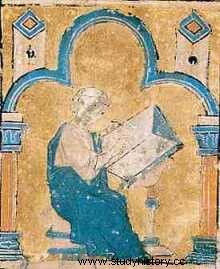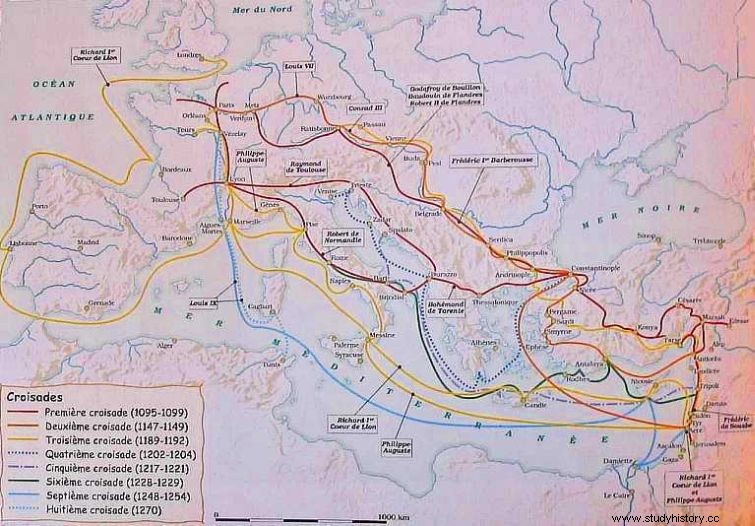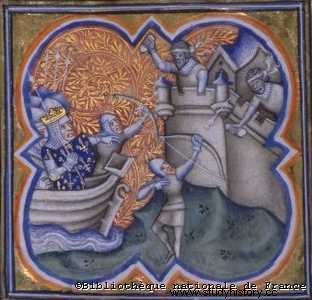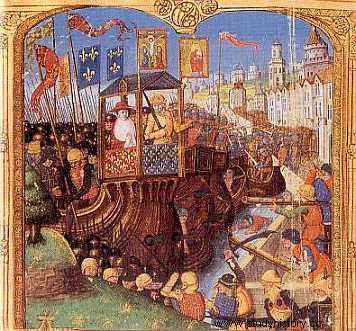Intro
Blessed by the pope and led by the monarchs of the Christian kingdoms of old Europe, this adventure was to represent all that the medieval spirit had in it. Despite the obvious military failure of the Crusades (with the exception of the first), Christianity emerged from it economically and culturally. The clash of cultures was clearly favorable to Europe, which was less advanced than the Middle East, which was then in decline. The Crusades also enabled the geopolitical creation of the Latin States of the East (County of Edessa and Tripoli, Principality of Antioch, Kingdom of Jerusalem) and the rise of the Italian maritime republics (Amalfi, Genoa, Pisa and Venice) .
The Latin States and the Italian Maritime Republics

All the Universe (Hachette)
Characteristics of the Crusades
A great medieval adventure
While European society was rigid and fragmented, all states (clergy, nobility, bourgeoisie and university) were involved in the eight expeditions, all castes combined:
- The high nobility supported them and fought for them
- The hierarchy of the clergy preached on their behalf from the cathedrals to the humblest of chapels.
- Lower nobility or younger families went there in search of reputation and honors, power and wealth.
- Trouvères and jugglers competed in poetry on the reconquest of the Holy Land, sometimes reaching sublime artistic heights in their verses.
- For any knight, "going on the Crusade" very quickly became an unavoidable duty, as much as respect and love for his lady.
A great economic investment
Over the course of the eight campaigns, everyone found something to their liking:
- Corporations of armorers, blacksmiths, tailors, tanners and craftsmen of all kinds equipped and supplied the crusaders
- Powerful corporations of traders and investors financed the various campaigns undertaken...
- Large shipowners and shipyard workers provided the many ships needed to transport this multitude.
- Finally, the common people of the countryside, just like the poor proletarians of the cities, fed the plebeian phalanxes of the armies:infantry and artillery units.
William of Tire writing his chronicle of the Crusades

(Histoire d'Outremer, 13th century, BN, Paris, MS 2631, f. 1r)
The role of women
Women, hitherto a passive feudal reality, took part in big business by making clothes, blankets and shelters:embroidering an infinity of banners with force of flames, signs, badges, pennants and flags that were soon to be displayed on the battlefields. the standard bearers of the armies. Not to mention the handkerchief marked with two or three tears of love from his lady, which every knight leaving for the Near East took with him tied around his arm or hidden against his heart. Often, the queen accompanied her royal spouse on the adventure, followed herself by the ladies of the highest nobility, also traveling with their husbands. At the same time as the countesses, marquises and other baronesses, a motley troop of prostitutes followed. There was also a whole horde of rascals, matchmakers, inveterate gamblers, crooks and murderers.
Very bloody expeditions
Once the cities were conquered, the Christian troops and their leaders indulged in atrocities that made the Christian chroniclers who had witnessed them shudder, some of them took pleasure in practicing cannibalism. Thus, after the sacking of Palestine, Raoul de Caen, chronicler of the First Crusade wrote:“At Maarat, our people cooked the adult pagans in pots and skewered the children to eat them roasted. » The Arab chronicler Usana ibn Munqidh, who had known the atrocities of the Second and Third Crusades first hand, noted in his memoirs:saw in them vermin that have superiority in valor and zeal for battle but nothing else, just as animals have superiority in strength and aggressiveness. » And this other:“The Frany stabbed the people of the Holy City and killed Muslims for a week. In the Al-Aqsa Mosque, they massacred 60,000 people. They rounded up and shut up the Jews in their synagogue and burned them alive. » Even their co-religionists did not escape the holy fury of the European troops:all the priests and practitioners of the Eastern rites residing in Jerusalem were expelled from the city and many murdered. Several Coptic priests who knew where "the Holy Cross of Christ" was hidden were ferociously tortured so that they revealed their secret.
A praying crusader
Free from all ties, the poor respond to the call of the crusade with more fervor than the other social classes. Sensitive to the promised heavenly rewards, they sew a fabric cross on their clothes, hence their name of "crusaders" which will be attributed to them.

13th century, BL MS Royal 2A XXII f. 220
French predominance
However, with our view today, the Crusades, these inordinate enterprises, absurd in a certain sense, revealed themselves to be of a high degree of imperfection and, above all, chaotic and irrational. This word “Frany” makes us aware that the Crusaders came from all parts of Europe, from Portugal to Lithuania, but they were mainly and essentially a French company. Thanks to this preponderance, France was always the center and axis of European policy:the most powerful and influential state on the continent. But France nevertheless emerged bloodless from the Crusades, losing more human lives there than all the other countries of Christendom combined. According to the opinion of several historians, the Crusades were the prologue to the Hundred Years' War in which France faced England under disadvantageous conditions from the start.
The Crusades

The Crusades
The First Crusade (1095 - 1099)
See the article dedicated to the First Crusade
The second crusade (1147 - 1149)
In 1144, the Muslims took over the county of Edessa (one of the four Eastern states founded by the Crusaders). The pope then ordered the formation of a new crusade. It was preached by Bernard of Clairvaux, to the assembly of Vézelay, in Burgundy, in 1146. The expedition was led by the king of France Louis VII and the Germanic emperor Conrad III. Disagreements between the leaders, lack of organization and military errors led to a series of setbacks by the Crusader forces. After his troops had been decimated at Dorylaea, Conrad returned to Germany. Louis VII, meanwhile, was inexperienced in waging war, and he often came up against the perfidy of the Byzantines. The survivors joined Jerusalem, then launched an attack against Damascus, without being able to seize this city. News of the arrival of Muslim reinforcements compelled the Christians to break camp and return ingloriously to Europe. In just two years, the prestige of the Crusader armies had fallen so low that one might think that no one would want to take up arms again.
Louis VII leaving for the Second Crusade
Louis VII takes his nickname "Young", because he was the youngest son of Louis VI le Gros. Raised by Suger at the abbey of Saint-Denis, he kept the monastic imprint and the little taste for weapons.

The Third Crusade - the "Crusade of Kings" (1189 - 1192)
Forty years passed, during which Christians and Muslims often lived as good neighbours. Many of the former Crusaders had married Arab women and had adopted many Eastern customs. Commercial exchanges were very intense between the ports of the Levant and those of the Italian coasts. The most important figure in the Muslim world was then the Sultan of Egypt, Salah al-Din, known as Saladin, who had extended his domination over a large part of the Levant and established good relations with the Christians. But the violation of this status quo by a few fanatical lords brought war to the region. Saladin defeated the Christians at the Battle of Attin and entered Jerusalem as the winner in 1187. The capture of the city led to the call for the Third Crusade. It was called the "kings' crusade" because at its head were the most prestigious sovereigns of the West:Emperor Frederic Barbarossa, King Philippe Auguste of France and King Richard the Lionheart of England. The assembled armies were very large. But barely arrived in Asia Minor, Frederick Barbarossa drowned for having crossed a river with his armor. The two surviving sovereigns took over the city of Saint-Jean d'Acre. Then events took another turn. The King of France had only one hurry:to return to his homeland and take advantage of Richard's absence to get his hands on the latter's French possessions. Left alone, the English king performed wonders, but he was no longer able to beat Saladin. So he concludes, in 1192, a truce with his brave adversary. The agreement stipulated that Jerusalem remained in the hands of the Muslims, who in return pledged to protect Christian pilgrims going to the Holy City. In addition, the Franks retained the ports of the Levant, as well as Cyprus.
Siege of Saint-Jean d'Acre
This crusade is certainly one of the most famous. The great Sultan Saladin was highly respected by Christians who considered him the “immaculate reflection of chivalry”. In front of him, Richard Coeur de Lion, a formidable warrior, very enduring in combat. The English king was immortalized by the adventures of Robin Hood.

(National Library of France)
The Fourth Crusade - the "Venice Crusade" (1202 - 1204)
The Fourth Crusade was inspired by Pope Innocent III, who called on the Christian rulers to take up arms again and free the Holy Sepulcher from the hands of the Muslims. Unlike the previous one, it was a crusade led by simple knights:Boniface de Montserrat, Baudouin de Flandre and Geoffroy de Villehardouin. Its original objective was Egypt, but it was completely diverted from its goal by the Venetians. They had undertaken to provide for the transport of the troops against the payment of a very large sum. As the crusaders had not managed to collect the money entirely, the Venetians demanded the capture of the city of Zara (today Zadar in Yugoslavia), which competed with the most serene republic:in five days, this Christian city was socket. Then the Crusaders headed for Constantinople, which they sacked in 1204. Venice had Byzantine territories ceded to it. Crusader leader Baudouin became the first emperor of the Eastern Latin Empire. Thus ended this crusade of Christians against other Christians:we were far from the ideal of Godfrey of Bouillon.
The Venetians divert the crusade to Constantinople

The "Children's Crusade" (1212) and the Fifth Crusade (1217 - 1221)
- The "Children's Crusade" (1212) :To make people forget the scandal of the Fourth Crusade, it was suggested that only innocent children could miraculously liberate the Holy Sepulchre. Fanatical preachers were able to convince the parents of more than 30,000 children to let them go unarmed, without supplies, completely destitute. In Genoa, dishonest ship captains smuggled them to Egypt and Tunisia, where, of course, they were sold as slaves.
- The Fifth Crusade (1217 - 1221) :The Fifth Crusade is also preached by Pope Innocent III. After an unsuccessful expedition by the kings of Cyprus and Hungary, the king of Jerusalem Jean de Brienne tried to invade Egypt, whose sultan controlled the Holy Land:he succeeded in taking Damietta in 1219 with the precious help of the Knights Templar. Three years later, the Western army advancing on the way to Cairo, was surprised by a flood of the Nile and had to capitulate:the Muslims forced them to liberate Damietta in exchange for the possibility of returning to sea without being worried.
The Sixth Crusade (1228 - 1229)
The Germanic Emperor Frederick II, excommunicated for having broken with Pope Gregory IX, was practically obliged to go on a crusade. He left very late and arrived in the Holy Land in 1228, with only 3,000 soldiers. After 5 months of negotiations with the sultan of Egypt Al-Kâmil, he manages by diplomacy to sign the treaty of Jaffa. He thus obtained the restitution of Bethlehem, Nazareth and even Jerusalem to the Latin kingdom. In Jerusalem, the Muslims keep possession of their temples and mosques, while the Christians recover the Holy Sepulchre. But this success was not recognized in the West, where people were scandalized by the agreement reached with the infidels! In 1244, the Muslims reconquered Jerusalem, which was never to return to Christian hands.
The Holy Roman Emperor Frederick II of Hohenstaufen (1220-1250)
Astonishing success of this Germanic emperor who recovers Jerusalem without having shed a drop of blood.

The Seventh Crusade (1248 - 1254)
In 1248, the Holy Land was taken over by the infidels:the Sultan of Egypt took over Jerusalem, which had been returned to Westerners following negotiations for the 6th Crusade, and massacred the Frankish army. Louis IX therefore undertakes an expedition to the heart of Egypt in order to attack the Saracens at the heart of their power, hoping to force the sultan to cede Jerusalem. However the religious ardor is less, Louis IX is obliged to force a certain number of its close relations to take the cross with him. He left with his wife Marguerite de Provence and his two brothers, Robert d'Artois and Charles d'Anjou. The king embarks at Aigues-Mortes, a royal port under construction which will allow France to have an outlet on the Mediterranean. After a stopover in Cyprus, the crusaders seize the city of Damietta, then prepare to march on Cairo where the sultan resided. It does not reach its goal, because it was attacked on the way by the Saracens and cut to pieces at Mansourah. The king's brother, Robert d'Artois is killed with many of his knights, the king and the rest of the army are taken prisoner. After negotiation, Louis IX is released against an enormous ransom of 400,000 pounds (paid partially by the Templars). Saint Louis spent another four years in the Holy Land, helping the Frankish principalities to reorganize their defense system. The reinforcements on which he had counted not coming, he ended up returning to France in 1254. It was also the death of his mother, Blanche de Castille, who was in charge of the regency, which will decide Louis to return after six years of absence.
Siege of Damietta
Despite the failure of the crusade, Saint Louis won the respect and consideration of the pope.

The Eighth Crusade (1270)
The failure of the Seventh Crusade, which Saint Louis interpreted as divine punishment, affected him greatly. Yet in the 13th century, Europe was no longer, as in the 12th century, mobilized against the infidels. As the poet Rutebeuf said:“One can easily win God without moving from one's country, by living from one's heritage. I do no harm to anyone. If I leave, what will become of my wife and children? It will be time to fight when the sultan comes this way. » The danger represented by the Muslims had become less pressing:already expelled from Sicily, they were methodically driven back from the Iberian Peninsula. Although the tomb of Christ was once again under the control of Islam, religious fervor had died down, as had dissipated the hopes of easy colonization and quick fortune that nourished the dreams of the little ones. lords. From this point of view, Saint Louis was not in tune with the times:the merchant bourgeoisies had understood that it would be impossible to dislodge or contain Islam, it was better to put up with its existence and maintain relations with it. Saint Louis did not share this point of view and wanted to attempt the impossible once again. He began to accumulate money, food and arms from 1267. In July 1270, he embarked for Tunis. He believed from his brother Charles of Anjou, King of Sicily, that the emir of that city intended to convert to Christianity. Exhausted by the heat and the lack of water, the old king died in front of Tunis. It was believed for a long time that it was the plague, but it seems that it would rather be dysentery. With this ultimate and ridiculous failure, the era of the crusades ended, of which Louis IX embodies the last figure.
